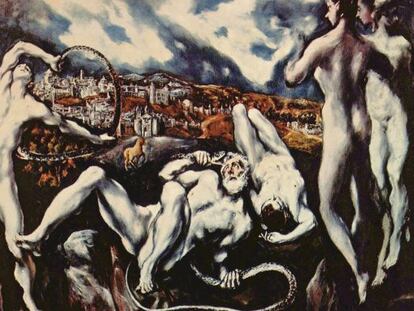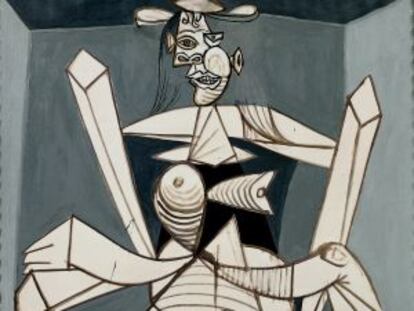Mysterious Frida Kahlo painting turns up after six decades in hiding
The early work bears all the hallmark intensity of the artist who lived with pain her whole life


A mysterious painting by Mexican artist Frida Kahlo which had been in hiding for more than 60 years is to go on sale at Sotheby’s in New York.
Kahlo painted Niña con collar (Girl with necklace) in 1929, the same year that she married famous Mexican muralist Diego Rivera. She was just 22, and was beginning to find her way as an artist after a childhood marked by polio and a nearly fatal 1925 bus accident which left her in pain for the rest of her life.
The unfinished painting was later photographed but then disappeared, only to reemerge now. Sotheby’s have provided little detail as to the painting’s history, only saying that it had remained with Kahlo up until death, at which point Rivera gave it to a woman who had helped her in the studio.
The new owner, now aged over 90, held onto the work at her home in California for six decades, but has now decided to sell.
With Frida Kahlo, we want the impossible: we want to always know more Art expert, Salomon Grimberg
Sotheby’s have estimated the value of the painting – still in good condition after being kept in a dark part of the owner’s house – in the $1.5 million to $2 million range, but this sum could easily be exceeded. In May, Kahlo’s 1939 painting Dos desnudos en el bosque (La tierra misma), was sold for over $8 million – a world record for both Kahlo and for Latin American artists in general.
While Niña con collar is an early Kahlo work, it has all the primordial power which characterizes her oeuvre. The figure in the painting, a young indigenous girl, is the absolute center of attention: not even the vibrant color scheme can compete with the intensity of her eyes. The eyes look at the viewer, but that gaze is also fixed on the future of the artist.
Experts believe the painting was left unfinished by Kahlo so that it could serve as a source of permanent inspiration. In the image are all the hallmarks of her celebrated later work: the frontal pose, the eyebrows, the jade bead necklace and the hooped earrings.
“The painting had special significance for her, and over the course of time it was the starting point for many of her self-portraits,” said Kahlo expert Salomon Grimberg.
Niña con collar has all the primordial power which marks Frida Kahlo's mature works
Kahlo, one of the most important artists of the 20th century, is also a cult figure and a pop icon, with interest in her personal life still intense 60 years after her death.
“When it comes to her, we want the impossible: we want to always know more and to know every detail about this woman who gave birth to herself,” Grimberg said.
In 2015, 25 letters from the Coyoacán-born artist to her Spanish lover were sold for $137,000. The letters to Josep Bartolí, a Catalan émigré living in New York, date from 1946 to 1949 and reveal her deep, almost adolescent passions.
“My Bartolí…I don’t know how to write love letters. But I wanted to tell you that my whole being opened for you. Since I fell in love with you everything is transformed and full of beauty…love is like an aroma, like a current, like rain. You know, my sky, you rain on me and I, like the earth, receive you,” Kahlo wrote in one of the letters.
English version by George Mills.
Tu suscripción se está usando en otro dispositivo
¿Quieres añadir otro usuario a tu suscripción?
Si continúas leyendo en este dispositivo, no se podrá leer en el otro.
FlechaTu suscripción se está usando en otro dispositivo y solo puedes acceder a EL PAÍS desde un dispositivo a la vez.
Si quieres compartir tu cuenta, cambia tu suscripción a la modalidad Premium, así podrás añadir otro usuario. Cada uno accederá con su propia cuenta de email, lo que os permitirá personalizar vuestra experiencia en EL PAÍS.
¿Tienes una suscripción de empresa? Accede aquí para contratar más cuentas.
En el caso de no saber quién está usando tu cuenta, te recomendamos cambiar tu contraseña aquí.
Si decides continuar compartiendo tu cuenta, este mensaje se mostrará en tu dispositivo y en el de la otra persona que está usando tu cuenta de forma indefinida, afectando a tu experiencia de lectura. Puedes consultar aquí los términos y condiciones de la suscripción digital.
More information
Últimas noticias
How Japan is trying to avert ‘digital defeat’
From digital curfews to blocking apps: How technology experts protect their children online
Why the price of coffee has skyrocketed: from Brazilian plantations to specialty coffee houses
Confined to a Cuban hospital: When electricity is a matter of life or death
Most viewed
- Pablo Escobar’s hippos: A serious environmental problem, 40 years on
- Reinhard Genzel, Nobel laureate in physics: ‘One-minute videos will never give you the truth’
- Why we lost the habit of sleeping in two segments and how that changed our sense of time
- Charles Dubouloz, mountaineering star, retires at 36 with a farewell tour inspired by Walter Bonatti
- The Florida Keys tourist paradise is besieged by immigration agents: ‘We’ve never seen anything like this’










































